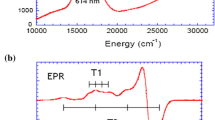Summary
The unusual difference spectrum obtained with halothane and reduced rat liver microsomal cytochrome P450 can be simulated by addition of trifluoro diazoethane to dithionite reduced microsomes. Chemical evidence and model reactions suggest that in both cases a trifluoromethyl carbene complex is formed with the reduced hemoprotein. The spectral dissociation constants of the two species are similar as are their competitive reactions with carbon monoxide. The partial destruction of the carbenoid-cytochrome P450 complex characterizes the ligand as a highly reactive species. It is assumed that under anaerobic conditions this complex is formed by a two electron reduction of halothane and that covalent binding to microsomal proteins proceeds by this carbenoid species. A possible relationship to the hepatotoxicity of polyhalogenated compounds and anesthetics is discussed.
Similar content being viewed by others
References
Affolter, H., Hartmann, G., Kopfhammer, V., Scheidegger, S.: Akute Massennekrose der Leber nach mehrmaliger Halothane-Narkose. Schweiz. med. Wschr. 94, 396–400 (1964)
Atherton, J. H., Fields, R.: Reaction of trifluoromethylcarbene with cis- and trans-but-2-ene. J. chem. Soc. (Lond.) 1967, 1450–1454
Blanchard, E. P., Simmons, H. E.: Cyclopropane synthesis from methylene iodide, zinc-copper couple, and olefins. J. Amer. chem. Soc. 88, 1337–1356 (1969)
Bruce, D. L.: What is a “safe” interval between halothane exposures? J. Amer. med. Ass. 221, 1140–1143 (1972)
Cardin, D. J., Cetinkaya, B., Lappert, M. F.: Transition metal-carbene complexes. Chem. Rev. 72, 545–574 (1972)
Carney, F. M. P., Van Dyke, R. A.: Halothane hepatitis. A critical review. Anesth. Analg. Curr. Res. 51, 135 (1972)
Castro, C. E., Kray, W. C., Jr.: Carbenoid intermediates from polyhalomethanes and chromium (II). The homogeneous reduction of geminal halides by chromous sulfate. J Amer. chem. Soc. 88, 4447–4455 (1966)
Cohen, E. N.: Metabolism of halothane-2-14C in the mouse. Anesthesiology 31, 560–565 (1969)
Duncan, W. A. M., Raventos, J.: The pharmacokinetics of halothane (Fluothane) anasthesia. Brit. J. Anaesth. 31, 302 (1959)
Fields, R., Haszeldine, R. N.: Carbene Chemistry. Part I. Reactions of fluoroalkyldiazocompounds. J. Chem. Soc. (Lond.) 1964, 1881–1889
Frommer, U., Ullrich, V., Staudinger, Hj.: Hydroxylation of aliphatic compounds by liver microsomes. Hoppe-Seylers Z. physiol. Chem. 351, 903–912 (1970)
Gornall, A. G., Bardawill, C. J., David, M. M.: Determination of serum albumins by means of the biuret reaction. J. biol. Chem. 177, 751 (1949)
Haley, F. C., Wyant, G. M.: The effect of halothane on the liver of dogs exposed to mild hypoxia. Canad. Anesth. Soc. J. 6, 271–276 (1959)
Hildebrandt, A. G., Leibman, K. C., Estabrook, R. W.: Metyrapone interaction with hepatic microsomal cytochrome P450 from rats treated with phenobarbital. Biochem. biophys. Res. Commun. 37, 477–485 (1969)
Jefcoate, C. R. E., Calabrese, R. L., Gaylor, J. L.: Ligand interaction with hemoprotein P450. III. The use of n-octylamine and ethyl isocyanide difference spectroscopy in the quantitative determination of high- and low-spin P450. Molec. Pharmacol. 6, 391–401 (1970)
Kirmse, W.: Carbene chemistry. 2nd ed. New York: Academic Press 1971
McLean, A. E. M.: Effects of hexane and carbon tetrachloride on microsomal cytochrome P450. Biochem. Pharmacol. 16, 2030–2033 (1967)
Moser, W. R.: The mechanism of copper-catalyzed additions of diazoalkanes to olefins. J. Amer. chem. Soc. 91, 1141–1146 (1969)
Peterson, J. A., Ullrich, V., Hildebrandt, A. G.: Metyrapone interaction with Pseudomonas putida cytochrome P450. Arch. Biochem. Biophys. 145, 531–542 (1971)
Rehder, K., Forbes, J., Alter, H., Hessler, O., Stier, A.: Halothane biotransformation in man. A quantitative study. Anesthesiology 28, 711–715 (1967)
Rosenberg, P. H., Wahlström, T.: Trifluoroacetic acid and some possible intermediate metabolites of halothane as haptens. Anesthesiology 38, 224–227 (1973)
Uehleke, H., Hellmer, K. H., Tabarelli-Poplawski, S.: Metabolic Activation of Halothane and its Covalent Binding to Liver Endoplasmic Proteins in vitro. Naunyn-Schmiedeberg's Arch. Pharmacol. 279, 39–52 (1973)
Ullrich, V.: Enzymatic hydroxylations with molecular oxygen. Angew. Chem. internat. Edit. 11, 701–712 (1972)
Ullrich, V., Schnabel, K. H.: Formation and binding of carbanions by cytochrome P450 of liver microsomes. Drug Metab. Disposition 1, 176–182 (1973)
Van Dyke, R. A., Wood, C. L.: Binding of radioactivity from 14C-labeled halothane in isolated perfused rat livers. Anesthesiology 38, 328–332 (1973)
Yates, P.: Transition metal-catalyzed decomposition of diazoalkanes is thought to proceed through a carbene metal complex. J. Amer. chem. Soc. 74, 5376–5381 (1952)
Author information
Authors and Affiliations
Rights and permissions
About this article
Cite this article
Mansuy, D., Nastainczyk, W. & Ullrich, V. The mechanism of halothane binding to microsomal cytochrome P450. Naunyn-Schmiedeberg's Arch. Pharmacol. 285, 315–324 (1974). https://doi.org/10.1007/BF00501461
Received:
Accepted:
Issue Date:
DOI: https://doi.org/10.1007/BF00501461




